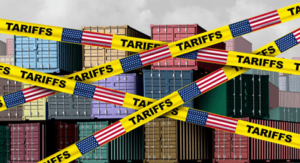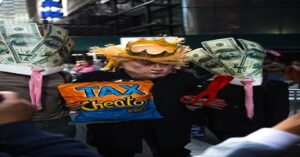
Trump’s Economic Agenda and Challenges
Trump’s Economic Agenda focuses on revitalizing American prosperity while navigating complex challenges. Central to his priorities is the extension of tax cuts from the 2017 Tax Cuts and Jobs Act, with an emphasis on reducing corporate tax rates and making full expensing a permanent feature to stimulate investment. However, this strategy faces the dual challenge of offsetting revenue losses and addressing the growing deficit.
Proposals to repeal costly provisions of the Inflation Reduction Act and overhaul the tax system, including introducing a national consumption tax, are pivotal. Beyond taxes, deregulation, fostering AI innovation, and avoiding disruptive policies like aggressive trade wars and mass deportations will shape Trump’s legacy as a pro-growth president.
Trump’s Economic Agenda
Donald Trump’s return to power signals a defining moment in American political history, marking the beginning of what many are calling the “Age of Trump.” As a dominant political figure of the post-2008 financial crisis era, Trump has built a legacy that seeks to reshape America’s economic landscape. However, the longevity of this legacy hinges on whether his policies foster long-term prosperity.
Read More: The Economics of Techno-Colonialism
Table of Contents
1. Reviving Tax Policies for Growth
Trump’s economic agenda emphasizes revisiting the Tax Cuts and Jobs Act (TCJA) of 2017 as a cornerstone of his strategy. With key provisions of the TCJA set to expire in 2025, Trump aims to cement its legacy by extending tax cuts for households and businesses.
The emphasis is on maintaining lower individual tax rates and expanding credits such as the child tax credit. Trump proposes making “full expensing” permanent. This provision, which allows businesses to deduct the full cost of certain investments in the year they occur, has already spurred investment and boosted wages.
To further enhance corporate competitiveness, Trump plans to lower the corporate tax rate and incentivize research and development (R&D) efforts. However, these initiatives raise concerns about rising deficits and long-term fiscal sustainability.
Read More: Can India Become a Developed Economy by Mid-Century?
2. Addressing Fiscal Sustainability Through Revenue Adjustments
Trump’s economic agenda underscores the need for balancing growth-oriented policies with fiscal responsibility. His tax cuts, while beneficial for growth, could exacerbate the federal deficit. To offset potential revenue losses, Trump’s administration has outlined three strategies:
Scaling Back the Inflation Reduction Act (IRA): Repealing or reducing costly provisions, such as the $7,500 electric vehicle credits, could free up funds to finance business tax cuts.
Modifying Household Tax Policies: Allowing some individual tax cuts to expire and eliminating deductions like mortgage interest could generate significant revenue.
Fundamental Tax Reforms: Trump’s administration envisions a simpler tax system, possibly replacing corporate income taxes with a national consumption tax and a tax on business cash flows. This approach would encourage savings and investment while accelerating productivity growth.
3. Trade Policies: A Delicate Balancing Act
Trump’s economic agenda is expected to take a refined approach in his second term, focusing on trade policies that address the mixed results of his first-term trade war with China. While these policies aimed to bolster domestic manufacturing, they instead reduced manufacturing employment and competitiveness. To avoid repeating past missteps, Trump plans to:
Support domestic industries without overburdening them with tariffs.
Promote fair trade practices while maintaining robust economic ties with key global partners.
A “border-adjustment tax” on imports and exports could align with Trump’s economic agenda by enhancing domestic production without escalating tensions.
4. Deregulation as a Catalyst for Prosperity
Deregulation is a hallmark of Trump’s economic agenda, reflecting his vision of reducing barriers to innovation and business growth. Key proposals include:
Replacing the FTC Chair: Trump plans to remove Lina Khan, whose tenure has been criticized for stifling mergers and acquisitions, which are vital for economic dynamism.
Rescinding AI Regulations: By overturning Biden’s executive order on artificial intelligence, Trump hopes to prioritize technological innovation over concerns about equity and job disruption.
These measures reflect Trump’s broader commitment to creating a business-friendly environment, fostering innovation, and positioning the U.S. as a global leader in emerging technologies.
5. Navigating Immigration Policies with Economic Sensitivity
Immigration policy remains a contentious issue in Trump’s economic agenda. While his previous stance on deporting millions of undocumented immigrants garnered criticism, his second-term strategy could adopt a more nuanced approach.
Disrupting businesses and communities through mass deportations could harm industries reliant on immigrant labor, such as agriculture and construction. Striking a balance between enforcing immigration laws and supporting economic growth will be crucial for maintaining his pro-business image.
6. Ensuring Energy Independence and Sustainability
Trump’s economic agenda includes revisiting energy policies established under the Biden administration. By repealing components of the Inflation Reduction Act, particularly clean-energy subsidies, Trump seeks to reduce government spending and redirect funds toward business tax cuts.
However, this approach risks undermining the transition to renewable energy and could face pushback from environmental advocates and industries benefiting from clean-energy incentives. Striking a balance between energy independence and sustainability will be essential for Trump’s long-term economic strategy.
7. Securing a Pro-Prosperity Legacy
Ultimately, Trump’s economic agenda and legacy as a “pro-prosperity president” hinge on avoiding pitfalls such as:
• Widening fiscal deficits through unchecked tax cuts.
• Failing to mitigate the negative effects of trade wars.
• Overstepping with restrictive immigration policies that harm businesses.
Conversely, success will require:
• Strategic tax reforms that promote investment and productivity.
• Pragmatic deregulation to stimulate innovation.
• Balanced trade and immigration policies that foster economic stability.
With Vice President-elect J.D. Vance by his side, Trump’s administration has an opportunity to chart a path that defines an era of economic dynamism.
Bottom Line
Donald Trump’s second-term economic agenda reflects ambitious goals to solidify his legacy as a transformative political figure. By prioritizing Trump’s economic agenda of tax reforms, deregulation, and pragmatic trade policies, he seeks to foster long-term prosperity. However, the success of his agenda will depend on balancing growth-driven initiatives with fiscal responsibility and social equity.
As the “Age of Trump” unfolds, his administration’s ability to navigate these challenges will determine whether his economic policies usher in a new era of American prosperity—or fall short of their lofty promises.





